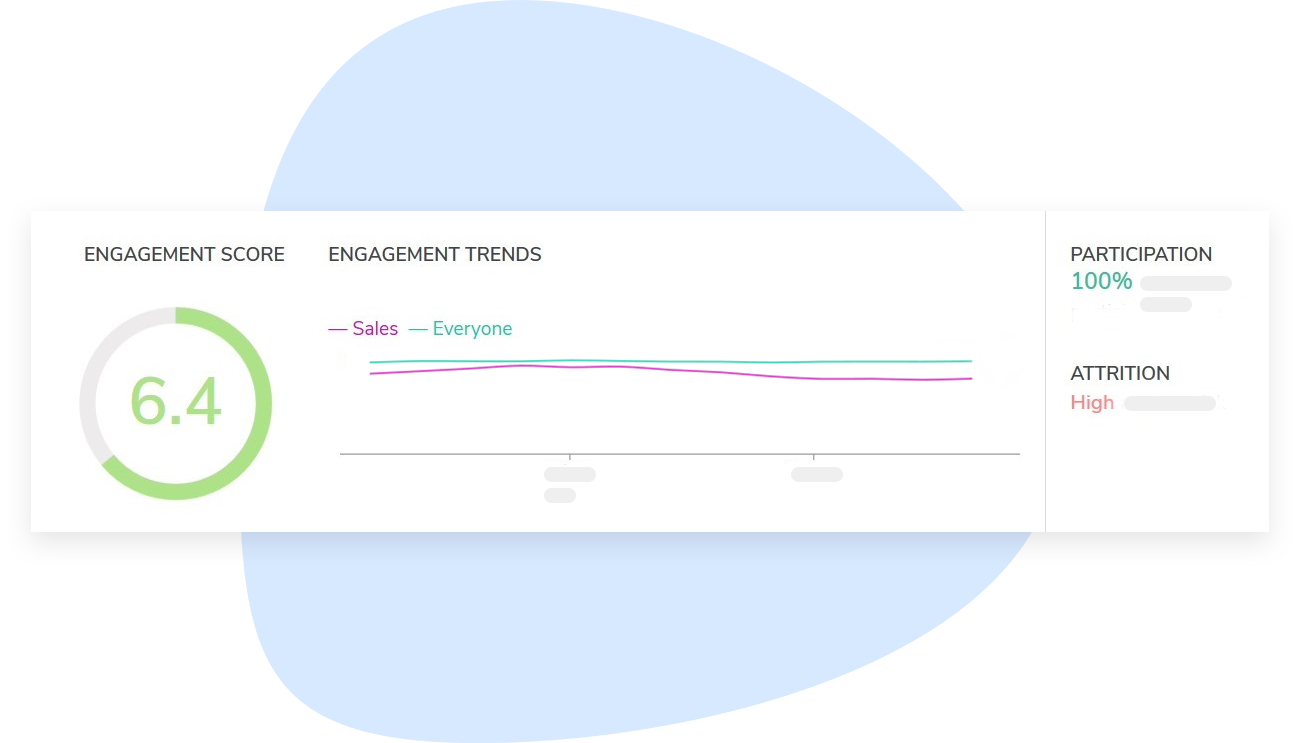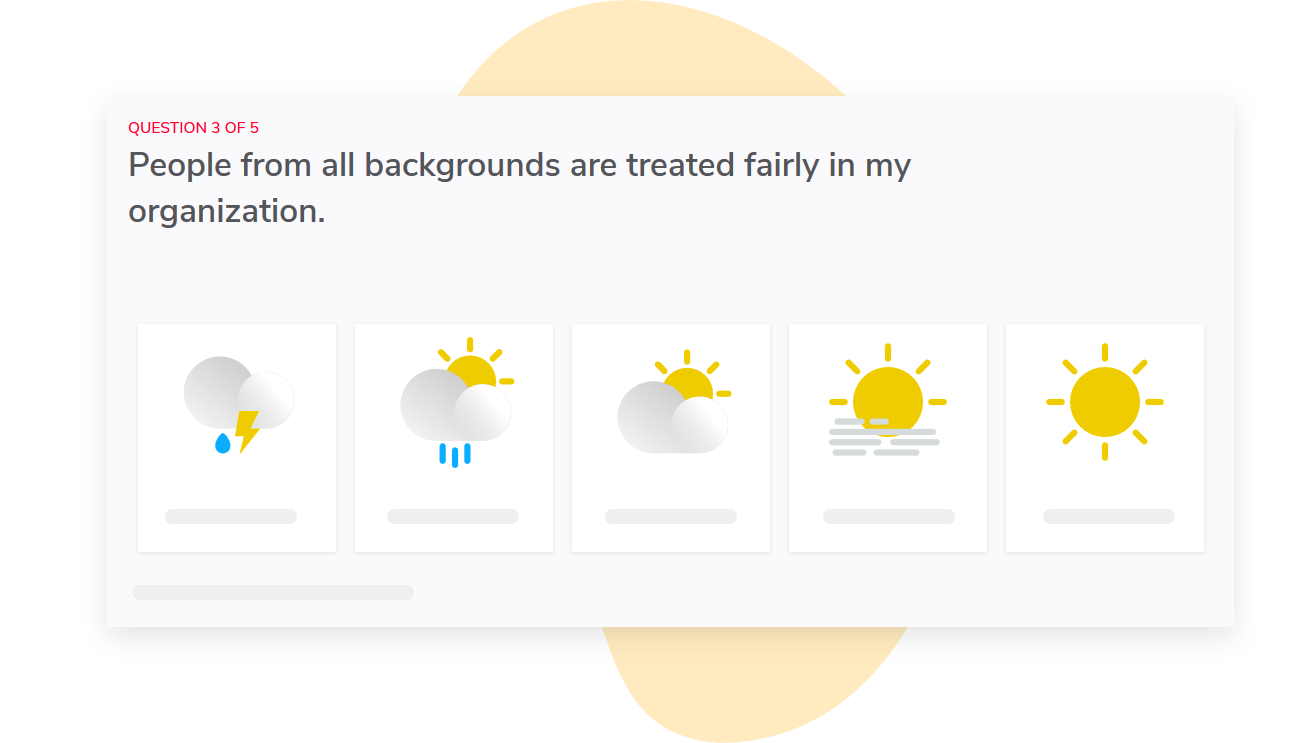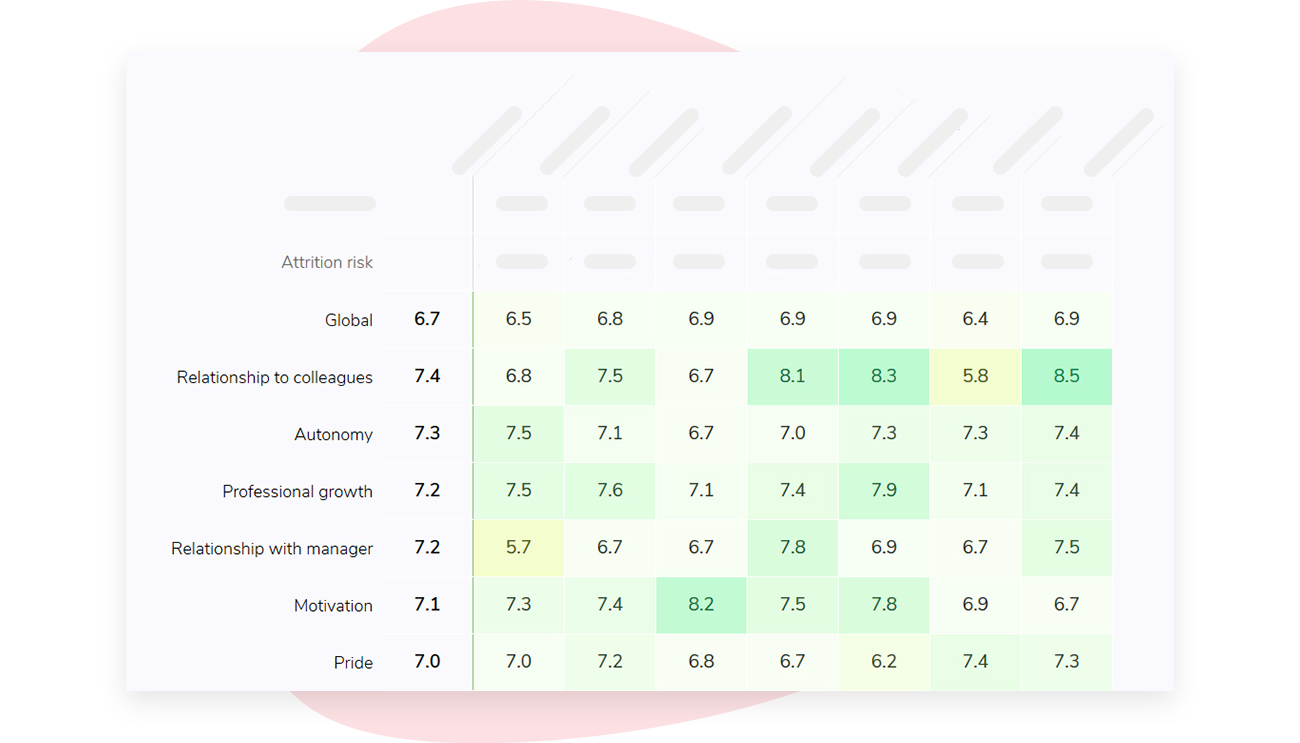员工敬业度工具
通过 Sparkbay 的员工敬业度工具获取准确且频繁的员工反馈
员工投入驱动企业发展。 Sparkbay 监控员工参与度,提醒任何脱离参与的迹象,助力您通过数据驱动建议改进。
我们的员工参与工具如何提升员工参与度
实时洞察
Sparkbay收集您组织中每位员工的反馈。
与传统调查不同,Sparkbay 的脉冲调查只需几分钟即可完成,且能即时提供数据。

提出正确的问题
通过智能问题分配,Sparkbay能在合适的时间向合适的人提出合适的问题。 这样,您能在员工敬业度下降的早期阶段及时发现。

做出数据驱动的决策
做出正确的决策对您的成功至关重要。
Sparkbay的交互式仪表板将为您的领导层提供针对每个员工群体的可操作洞察: 直接经理、部门、办公室、任期、职位、人口统计等。

根据反馈采取行动:闭环管理
收集员工反馈只是开始。
Sparkbay 让您的管理者成为团队中的变革推动者,提供个性化可操作建议。

提升员工敬业度
实地查看Employee engagement tool FAQ
What is an employee engagement tool?
An employee engagement tool is a software designed to measure and improve the level of involvement and commitment of employees within an organization. The purpose of these tools is to provide a way for companies to gauge how engaged their employees are and identify areas where they can improve. Some of the key features of employee engagement tools include employee surveys, pulse polls, feedback mechanisms, goal tracking, recognition and reward programs, and communication tools. These tools are used by HR departments and managers to collect data on employee satisfaction, motivation, and commitment and to make data-driven decisions about improving the workplace.
Can I use an employee engagement software to engage my remote employees?
Yes, you can use an employee engagement software to engage your remote employees. In fact, employee engagement software can be especially beneficial for remote teams as it provides a way for managers to connect with employees and foster a sense of community and connection, even when employees are working from different locations.
Remote employee engagement tools often include features such as virtual team-building activities, anonymous feedback mechanisms, and communication tools that facilitate regular check-ins and interaction between team members. These tools can help remote employees feel more connected to the organization and their colleagues, and can also provide a way for managers to monitor and address any potential issues related to remote work.
So, if you have a remote team, an employee engagement software can be a valuable tool in keeping your employees connected, engaged, and motivated.
What makes a great employee engagement software?
A great employee engagement software should have the following characteristics:
- User-friendly interface: The software should be easy to use and accessible to all employees, regardless of their technical proficiency.
- Customization: The software should allow for customization so that it can be tailored to meet the specific needs of your organization.
- Analytics and reporting: The software should provide actionable data and insights that can be used to make informed decisions about employee engagement.
- Multi-channel communication: The software should support multiple communication channels, such as email, text, and in-app notifications, to reach employees effectively.
- Employee feedback: The software should provide employees with an opportunity to provide feedback and have their voices heard.
- Integration with other tools: The software should be able to integrate with other HR and business tools, such as HR management software, project management tools, and performance management systems.
- Secure data protection: The software should have robust security features to protect sensitive employee data.
- Regular updates: The software should be regularly updated to ensure that it remains up-to-date with the latest employee engagement best practices.
- User support: The software should provide adequate user support, including training and technical assistance, to ensure that employees and managers can effectively use the software.
By having these features, a great employee engagement software can help organizations to better understand and improve the engagement levels of their employees.
Why do you need an all-in-one engagement solution?
The main purpose of employee engagement tools is to improve the level of involvement and commitment of employees within an organization. These tools are designed to help companies understand what drives employee satisfaction, motivation, and commitment, and to provide a way for companies to take action based on that information. The goal is to create a positive workplace culture that promotes employee well-being, productivity, and loyalty.
Some of the specific objectives of employee engagement tools include:
- Measuring employee satisfaction and engagement levels: Employee engagement tools allow companies to regularly measure employee satisfaction and engagement levels, and to track changes over time.
- Identifying areas for improvement: Employee engagement tools provide data and insights that can be used to identify areas for improvement within the workplace.
- Encouraging employee involvement: Employee engagement tools provide a platform for employees to share their thoughts and ideas, and to get involved in engagement initiatives.
- Improving communication: Employee engagement tools can facilitate better communication between employees and managers, helping to foster a sense of connection and community within the workplace.
- Providing recognition and rewards: Employee engagement tools can help organizations to recognize and reward employees for their contributions, and to create a positive, rewarding workplace culture.
In conclusion, the main purpose of employee engagement tools is to improve the overall engagement and satisfaction levels of employees within an organization, which, in turn, can lead to improved productivity, employee retention, and business success.
What are the different measurement tools to measure employee engagement?
There are several measurement tools that organizations can use to measure employee engagement, including:
- Employee Surveys: Employee surveys are one of the most common methods for measuring employee engagement. Surveys can be administered online or on paper, and can ask employees about a range of topics, including job satisfaction, motivation, and organizational culture.
- Pulse Surveys: Pulse surveys are short, frequent surveys that organizations can use to regularly check in with employees and measure engagement levels.
- Exit Interviews: Exit interviews can provide valuable information about why employees are leaving the organization, including any issues with engagement or workplace culture.
- Employee Net Promoter Score (eNPS): eNPS measures employee satisfaction by asking employees how likely they are to recommend their workplace to others.
- Performance Management Systems: Performance management systems can provide insights into employee engagement by tracking employee performance and engagement metrics, such as attendance and turnover rates.
- Employee Focus Groups: Employee focus groups can provide an opportunity for employees to share their thoughts and opinions on a range of engagement-related topics in a group setting.
These are just a few examples of the many tools available for measuring employee engagement. The most effective approach will depend on the specific needs and goals of your organization, as well as the size and demographics of your workforce.
What tools do I need for my employee engagement program?
The tools you need for your employee engagement program will depend on your specific goals and the needs of your organization. However, here are some commonly used employee engagement tools that you may consider:
- Employee Surveys: Employee surveys can help you measure employee satisfaction and engagement levels and provide valuable insights into what drives engagement in your workplace.
- Feedback and Recognition Tools: Feedback and recognition tools can help you provide regular feedback to employees and reward them for their contributions, which can help to boost engagement.
- Employee Engagement Platforms: Employee engagement platforms are all-in-one solutions that provide a range of tools and resources designed to enhance employee engagement, including pulse surveys, employee recognition and rewards, and data analytics.
- Employee Wellness Programs: Employee wellness programs can help promote employee well-being, which is a key driver of engagement.
Remember that the specific tools you need for your employee engagement program will depend on your specific goals and the needs of your organization. A comprehensive employee engagement strategy will likely involve a combination of these tools and may also include additional resources, such as training and development programs, recognition and reward programs, and internal communications campaigns.
Does every single employee need to be included in the employee engagement survey?
Not every single employee needs to be included in an employee engagement survey. The scope of the survey will depend on the goals and objectives of the organization. Here are a few factors to consider:
- Representativeness: Organizations may want to ensure that the survey includes a representative sample of employees across different departments, locations, and job functions.
- Response Rate: The response rate of the survey can impact the validity and reliability of the results. To ensure a high response rate, organizations may want to include as many employees as possible in the survey.
- Resources: Conducting a comprehensive employee engagement survey can be resource-intensive, and organizations may want to prioritize including employees who will provide the most valuable feedback.
Ultimately, the decision of which employees to include in an employee engagement survey will depend on the specific needs and goals of the organization. It's important to strike a balance between representativeness, response rate, confidentiality, and resources when determining the scope of the survey.
